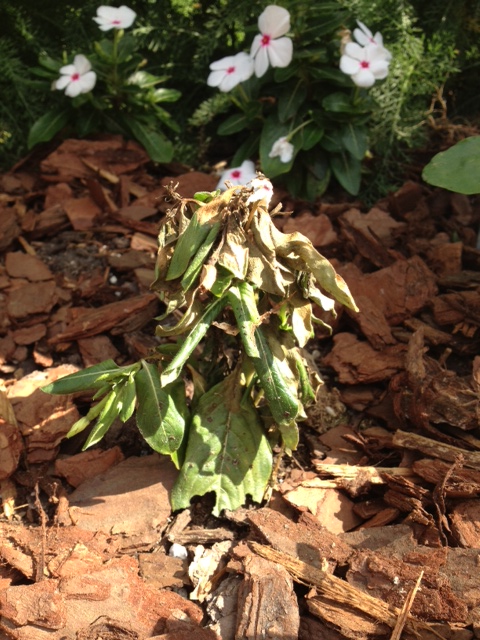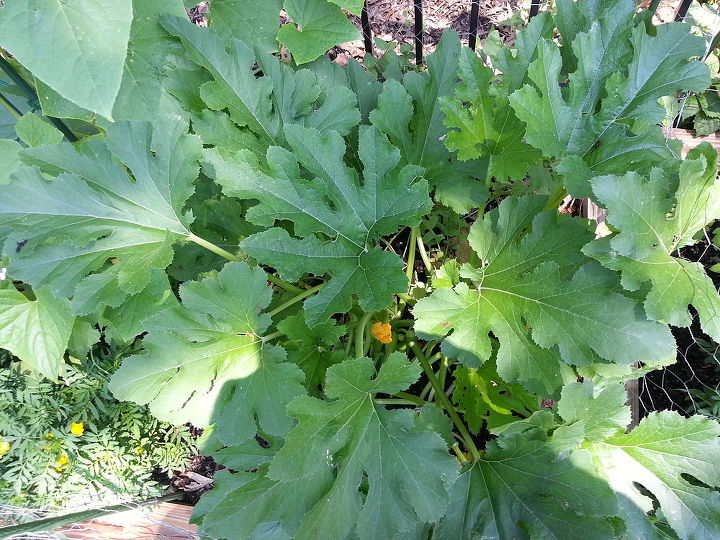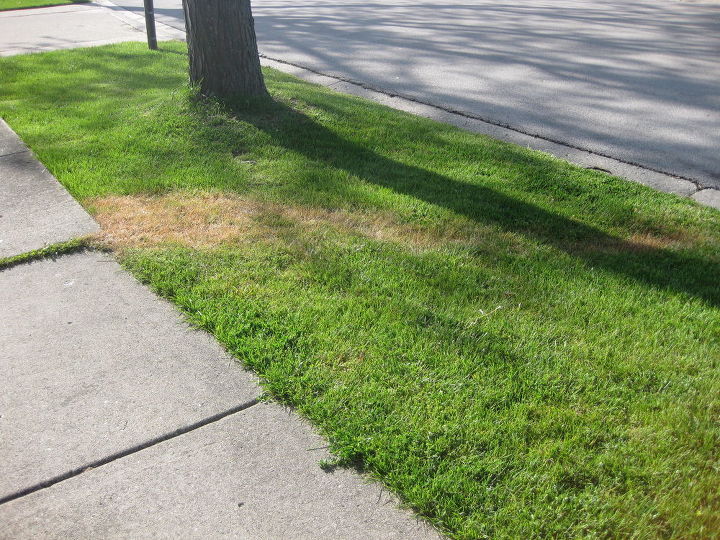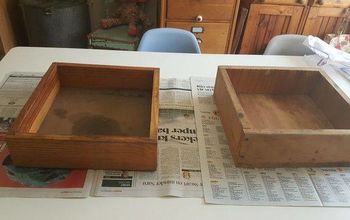Vinca having a bad year??
-
No disease I know of. Maybe you need to amend the soil or remove the top portion and put fresh soil in. Like a pot needs new soil every year maybe something has afflicted your soil.
 Cyndi Moore Tippett
on May 23, 2013
Helpful Reply
Cyndi Moore Tippett
on May 23, 2013
Helpful Reply -
-
Thanks, Cyndi. I actually planted these in great soil that was put into these areas last year and enriched this year. I just don't think that's it. But thanks for the suggestion!
 Martha K
on May 23, 2013
Helpful Reply
Martha K
on May 23, 2013
Helpful Reply -
-
@Martha K , I think it is all the rain we have been having. I have noticed it in the flats sitting in the nursery as well. It looks like Botrytis which is a fungus rot. Try to remove the dead ones take away as the fungus can release spores and contaminate the rest of your plants. Maybe things will improve if the rain will go away for a bit.
 360 Sod (Donna Dixson)
on May 23, 2013
Helpful Reply
360 Sod (Donna Dixson)
on May 23, 2013
Helpful Reply -
-
Have had this happen to me last year. Not all of the plants died, but a good amount of them did. Just got some new ones to plant this week and hope that all goes well with them. Have no idea of what caused it.
 Caroline
on May 23, 2013
Helpful Reply
Caroline
on May 23, 2013
Helpful Reply -
-
Could be root rot if the soil has been very wet or maybe too much fertilizer. Insects are always a possibility too. One thing confuses me a bit. Why are you having to replant every year? Don't know if you have Vinca Major or Minor but both are perennials.
 Judy
on May 24, 2013
Helpful Reply
Judy
on May 24, 2013
Helpful Reply -
-
@Judy There is an annual flower that isn't one of the vines. The flowers look somewhat alike in shape, but the annual flower is Catharanthus roseus and also known as Madagasgar perewinkle. The vining Vinca major and minor are also called periwinkle sometimes, so it gets very confusing. The annual flower will take a good amount of sun, while the vine isn't as comfortable in the the abusive southern sun.
 360 Sod (Donna Dixson)
on May 24, 2013
Helpful Reply
360 Sod (Donna Dixson)
on May 24, 2013
Helpful Reply -
-
The one I am having trouble with is the annual flower - not the vine - Bright Eye to be more specific.
 Martha K
on May 24, 2013
Helpful Reply
Martha K
on May 24, 2013
Helpful Reply -
-
Snails or slugs??
 Sheryl S
on May 24, 2013
Helpful Reply
Sheryl S
on May 24, 2013
Helpful Reply -
-
I haven't seen snails or slugs - of course there could be. I have planted in three different spots and have lost plants in all three.
 Martha K
on May 25, 2013
Helpful Reply
Martha K
on May 25, 2013
Helpful Reply -
-
My guess is that the plant had not been in the sun enough before purchasing and planting. Small amounts of exposure daily to get the plant ready for the sun/heat is needed, Also, you can always use epsom salt to prevent root shock and is a great fertilizer/insecticide without using chemicals.
 D Burton
on May 25, 2013
1 marked as helpful Reply
D Burton
on May 25, 2013
1 marked as helpful Reply -
-
D Burton, I've never heard of the epsom salt treatment. How do I do this?
 Jacqueline Elaine
on May 25, 2013
Helpful Reply
Jacqueline Elaine
on May 25, 2013
Helpful Reply -
-
A lot of vinca bedding plants this year are suffering from powdery mildew. If you are getting replacement plants from the same source each time, you are probably just repeating the infestation. You could switch to the other vinca variety which has larger blooms (I can't think of the name of this variety) and does not seem to have this problem. I have noticed in my area that many of the vinca (such as bright eyes) offered in my area show signs of powdery mildew or the plants are spindly and leggy. I would avoid buying these plants.
 Carolyn E
on May 25, 2013
1 marked as helpful Reply
Carolyn E
on May 25, 2013
1 marked as helpful Reply -
-
I have a friend who owns a greenhouse in Michigan. She confirmed to me what I'd read about a lot of impatiens having disease this year...not everywhere but in different areas across the country. The problem apparently comes when the same plant (impatiens) is planted in the same bed for several years in a row. That vinca reminds me a lot of impatiens (flat flowers, etc) so maybe it's the same thing for vinca. This is essentially what Carolyn E stated above. Here is a link to an article from the Chicago Tribune...there are many others if you google it. http://articles.chicagotribune.com/2013-04-22/news/ct-met-impatiens-disease-20130422_1_downy-mildew-plants-disease
 Lori
on May 26, 2013
Helpful Reply
Lori
on May 26, 2013
Helpful Reply -
-
I'm having the same problem with my Vinca. Last year I had Impatients in the same spots the Vinca is this year. The nursery told me it wouldn't affect the Vinca, but I'm thinking it is. It looks a lot like the Impatients did last year. I did find this explaination of what might be happening. Hope it helps. Once established, vinca requires very little water. Most gardeners tend to overwater vinca. When watering, do it early in the morning so the foliage can dry as quickly as possible Airflow is critical with vinca. Give it room to grow. Improving air flow reduces disease problems. Proper spacing allows the soil to dry out quickly after watering or fertilizing. There are several diseases vinca can get, and I will mention three of the most common. The No. 1 disease is phytophthora stem blight and root rot. The symptoms of this disease are: dark brown to black lesions form on the stems and branches, causing the portions above to wilt and die back. Symptoms of root rot include yellowing and scorching of leaves, poor growth, and stunting of plants, wilting, and eventual death. Plants with reduced root systems and individual roots tend to slough off the outer tissue leaving the inner core behind. Another fatal disease is rhyzoctonia stem and root rot. Plants affected by this turn yellow, wilt and collapse. Plants are normally stunted, their roots have brown lesions, leaves turn yellow and plants wilt even when soil moisture is sufficient. Symptoms of this disease are similar to phytophthora. Alternaria disease causes black, greasy looking spots on foliage that start on the lower leaves and gradually moves up the plant. As the spots increase in number, the leaves turn yellow and fall off. To help control these disease problems, plant in beds with good soil drainage. When planting, till the area or loosen the soil and add compost or other organic materials. Do not over fertilize and over water. Try to keep the foliage as dry as possible. Remove and destroy infected plants or leaves as soon as you see them. Hot weather usually stops most of the disease progression. Rotate your flower beds by not planting vinca in the same place year after year unless you replace the soil.
 Madelyn Upleger
on Jul 15, 2013
Helpful Reply
Madelyn Upleger
on Jul 15, 2013
Helpful Reply -
-
I had vinca this summer and it did wonderfully here in NH in fact it was blooming like crazy right up until last night when the freeze killed it along with all of my zinnia's, morning glories and many other varieties . I have noticed that when transplanting Vinca it sometimes takes awhile to recover, more so than other annuals that I plant. I am also thinking that the plants you got may have already been affected by a disease when you bought them unless you grew them from seed . the impatients I planted did well after almost losing them to to much rain in June but they recovered nicely and didn't get the mold that I have had trouble with in the past .
 Bonnie Bassett
on Oct 26, 2013
Helpful Reply
Bonnie Bassett
on Oct 26, 2013
Helpful Reply -
-
Hummm i thought it was me or all the rain we got this year, vincas have done horrible this year, i have lost almost all that i have planted. i did a large raised bed this year, and planted the faithful lil guys and kerput lost them
 Kat Davis-Moran
on Nov 03, 2013
1 marked as helpful Reply
Kat Davis-Moran
on Nov 03, 2013
1 marked as helpful Reply -
Related Discussions
GNATS - How to get rid of them?
Somehow my house and garden got tiny gnats that killed my fuchsia plant and fly everywhere. I have tried ALL the Web recommendations - soap and oil dishes, sand in th... See more
Marigolds growing! Should I pinch the buds?
My marigold plants are growing. I heard that pinching the buds until Autumn will allow them to grow without killing the plant. Is this true?
Growing garlic
Growing our first garlic, should we wait until the leaves are drying out before we pick it? Husband picked first one today along with our first potatoes.
How to keep mice out of your garden?
Hi everyone, I have mice in my garden destroying my vegetables and I have also noticed them in the barn and shed. Please can someone tell me how to prevent them from ... See more
What's the best flower/plant to grow in Texas?
I know that opinions vary, but what's your opinion?!I have great luck w Rosemary plants. Green all year long.
Squash Plants Large and Healthy and no Squash Growing?
2nd Season in a ROW! Squash plants growing large and healthy leaves and the stems near the roots are looking healthy and turning dark green, getting flowers that grow... See more
Trail of dead grass mystery?
Trail of dead grass appeared two weeks ago that starts in neighbor's yard and goes to the sidewalk, then continues past the sidewalk in a line into the grass into my ... See more





